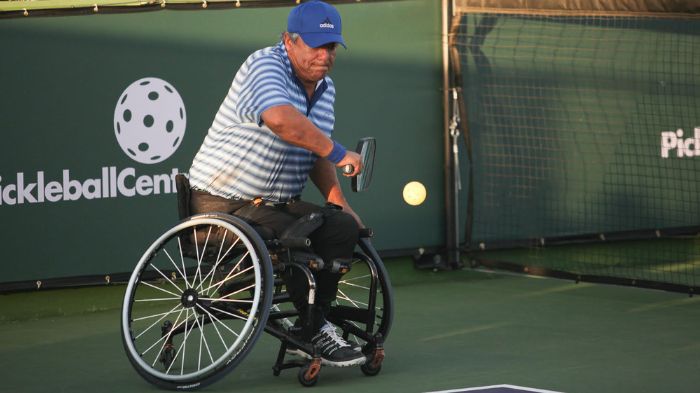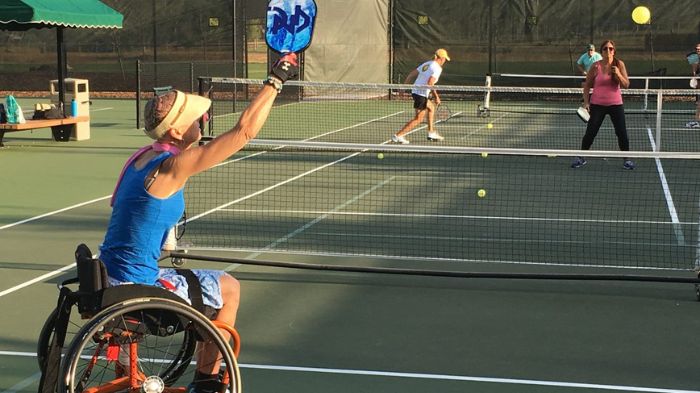Hey there! Ever heard of wheelchair pickleball? It’s a fantastic variation of the popular game that involves players in wheelchairs. In this version, one or more players on the pickleball court participate from their wheelchairs, adding an exciting twist to the game.
Now, here’s the catch: unlike traditional pickleball, players in wheelchairs must remain seated throughout the game and are not allowed to stand up in their chairs. It’s a unique adaptation that opens up the sport to individuals with mobility limitations, allowing them to actively participate and have a blast on the court.
So, if you’re curious about wheelchair pickleball and how it adds an inclusive and exciting element to the game, keep on reading.

History of Wheelchair Pickleball
Pickleball, a sport known for its inclusivity and adaptability, has extended its reach to individuals with mobility limitations through the creation of wheelchair pickleball.
This variation of the game allows wheelchair users to actively participate and enjoy the sport. Let’s explore the history and evolution of wheelchair pickleball, and how it has become an integral part of the pickleball community.
Wheelchair pickleball emerged as an adaptation of traditional pickleball in response to the growing interest of individuals with mobility impairments.
The exact origins of wheelchair pickleball are unclear, but it is believed to have gained traction in the early 2000s. Players started experimenting with modified rules and equipment to accommodate wheelchair users, making the game more inclusive and accessible.
Rules and Equipment
In wheelchair pickleball, there are specific rules that cater to the unique features and considerations of players using wheelchairs. Let’s take a closer look at these rules as outlined in the 2022 USA Pickleball Rulebook:
Section 1 – The Game – Unique Features
Players using wheelchairs have the advantage of allowing the ball to bounce twice before returning it. The second bounce can occur anywhere on the playing surface, providing more time for wheelchair players to reach and return the ball.
Section 2 – Court And Equipment
The recommended playing surface area for wheelchair play is 44 feet wide and 74 feet long. However, in stadium courts, the size for wheelchair play is slightly larger, measuring 50 feet wide by 80 feet long.
Section 3 – Definitions
Players using wheelchairs refer to individuals, regardless of disability, who play the game while seated in a wheelchair. The wheelchair is considered part of the player’s body, enabling anyone who wishes to play in a wheelchair to do so.
Section 4 – The Serve, Service Sequence, And Scoring Rules
During the serve, both rear wheels of the wheelchair must be on the playing surface behind the baseline. The wheels should not touch the court within or outside the baseline‘s imaginary extensions.
Section 7 – Fault Rules
It is considered a fault if a player using a wheelchair fails to return the ball before it bounces three times on the receiving player’s side of the net.
Section 9 – Non-Volley-Zone Rules
All volleys must be initiated outside of the non-volley zone. However, for players using wheelchairs, the front (smaller) wheels are allowed to touch the non-volley zone during a volley.
It is deemed a fault if the volleying player or anything that has contact with the volleying player while in the act of volleying touches the non-volley zone. For players using wheelchairs, the front wheels can touch the non-volley zone.
If, during the act of volleying, the player’s momentum causes contact with anything touching the non-volley zone, including the player’s partner, it is considered a fault. However, the front wheels of the wheelchair can touch the non-volley zone for players using wheelchairs.
Once the rear wheels of a wheelchair have touched the non-volley zone for any reason, the player using a wheelchair cannot volley a return until both rear wheels have made contact with the playing surface outside the non-volley zone.
Section 12 – Sanctioned Tournament Policies
In sanctioned pickleball tournaments, specific policies are in place to accommodate wheelchair players and ensure their active participation. Let’s delve into the details of the tournament policies outlined in Section 12 of the rulebook:
12. A Event Categories – Wheelchair: Singles and Doubles
Within the tournament framework, a designated event category called “Wheelchair” is established to cater specifically to wheelchair players. This category allows wheelchair players to compete in both singles and doubles matches.
12.A.3
- Players using wheelchairs may play in Men’s Doubles, Women’s Doubles, or Mixed Doubles with either standup partners or wheelchair doubles:
- Players using wheelchairs have the opportunity to participate in various doubles events alongside both standup partners and other players using wheelchairs.
- In the Men’s Doubles event, a wheelchair player can team up with another wheelchair player or a standup player.
Similarly, in the Women’s Doubles event, wheelchair players have the flexibility to form teams with either wheelchair players or standup players. - The Mixed Doubles event allows wheelchair players to pair up with either wheelchair players or standup players of the opposite gender.
Benefits and Challenges of Wheelchair Pickleball

- Physical Health Benefits:
- Promotes cardiovascular health and fitness through engaging in aerobic activity.
- Enhances muscular strength and endurance, particularly in the upper body.
- Improves coordination, agility, and balance through dynamic movements on the court.
- Community and Camaraderie:
- Fosters a sense of belonging and community among wheelchair pickleball players.
- Provides opportunities for social interaction, friendship, and support.
- Creates an inclusive environment where players can share experiences and understand each other’s challenges.
- Mental and Emotional Well-being:
- Boosts self-confidence and self-esteem through active participation in a competitive sport.
- Offers a positive outlet for stress relief and mental relaxation.
- Provides a sense of accomplishment and personal fulfillment.
- Adaptability and Inclusion:
- Allows individuals with mobility impairments to actively participate in a popular sport.
- Promotes inclusivity and breaks down barriers between players of different abilities.
- Celebrates diversity and encourages equal opportunities for all players.
Challenges of Wheelchair Pickleball
- Technical Adjustments:
- Players must adapt their playing techniques and strategies to accommodate wheelchair mobility.
- Learning to maneuver the wheelchair effectively on the court requires practice and skill development.
- Grip and swing technique adjustments may be necessary due to the different positioning in a wheelchair.
- Court Positioning and Coverage:
- Wheelchair players need to master court positioning to optimize their reach and coverage.
- Strategic positioning becomes crucial to anticipate shots and maximize defensive and offensive play.
- Physical Demands:
- Wheelchair pickleball can be physically demanding, requiring strength and endurance in the upper body.
- Players need to maintain good stamina to sustain the fast-paced nature of the game.
Despite the challenges, the benefits of wheelchair pickleball outweigh the obstacles. The sport offers a unique platform for individuals with mobility impairments to enjoy physical activity, build relationships, and experience the joy of competition.
With dedication, practice, and a supportive community, wheelchair pickleball empowers players to embrace an active lifestyle and thrive on the court.
Also Read Abou: Pickleball Communities And Chop in pickleball
Inclusive Community and Competitive Opportunities
The pickleball community has embraced the inclusion of wheelchair players, fostering an environment that celebrates diversity and encourages participation for individuals of all abilities. Many organizations and clubs now offer dedicated wheelchair pickleball programs, providing opportunities for players to engage in recreational play and competitive events.
The competitive landscape for wheelchair pickleball has grown significantly, with tournaments and leagues specifically catering to wheelchair players.
These events provide a platform for wheelchair pickleball athletes to showcase their skills and compete at various levels, from local to international competitions. The inclusivity of the sport has allowed wheelchair players to thrive and be recognized for their talent and dedication.
Tips for Playing Wheelchair Pickleball
Playing wheelchair pickleball successfully requires a combination of technique, strategy, and adaptability. Here are some essential tips for wheelchair pickleball players.

Physical Health and Fitness
- Prioritize warming up and stretching before playing to prevent injuries and improve flexibility.
- Engage in regular cardiovascular exercises and strength training to enhance overall fitness.
- Work on upper body strength through specific exercises targeting the arms, shoulders, and core muscles.
- Practice agility drills to improve coordination and balance in the wheelchair.
Court Awareness and Strategy
- Familiarize yourself with the dimensions of the court and understand the strategic zones.
- Develop court positioning skills to optimize your reach and coverage on the wheelchair.
- Anticipate shots by observing your opponents’ movements and positioning on the court.
- Learn different shot techniques such as dinks, volleys, and groundstrokes to vary your gameplay.
Wheelchair Maneuverability
- Practice maneuvering your wheelchair efficiently, including starting, stopping, and turning smoothly.
- Learn to use small adjustments in wheel movements to fine-tune your positioning on the court.
- Experiment with different wheelchair positions and angles to optimize your shots and defensive play.
Communication and Teamwork
- If playing doubles, establish clear communication with your partner to coordinate shots and movement.
- Develop effective strategies with your partner to cover the court efficiently and maximize teamwork.
- Communicate your needs and preferences to your partner and fellow players to ensure a cohesive game.
Equipment and Accessories
- Invest in a well-fitted and comfortable wheelchair that provides stability and maneuverability.
- Consider using gloves, or what is penhold grip in pickleball? Aids to maintain a firm hold on the paddle during intense gameplay.
- Explore adaptive equipment options such as paddle modifications or specialized wheelchair attachments.
Learn from Experienced Players
- Seek guidance from experienced wheelchair pickleball players to learn tips and techniques.
- Attend clinics, and workshops, or join wheelchair pickleball leagues to receive coaching and support.
- Observe and analyze matches of skilled wheelchair players to gain insights into their strategies and gameplay.
Future of Wheelchair Pickleball
- The future of wheelchair pickleball looks promising, with continued growth and development on the horizon. As awareness and understanding of the sport increase, more players are likely to participate, leading to expanded opportunities for competition and a greater sense of community.
- Advancements in adaptive equipment and technology will further enhance the playing experience for wheelchair pickleball athletes. Innovations in wheelchair design and specialized equipment may improve maneuverability, comfort, and overall performance on the court.
- Moreover, the integration of wheelchair pickleball into mainstream pickleball events, such as tournaments and leagues, will promote further inclusivity and recognition for wheelchair players. This integration will help break down barriers and create a more unified pickleball community.
- In conclusion, wheelchair pickleball has become a vital part of the pickleball landscape, offering individuals with mobility impairments an avenue to actively participate in the sport.
- Through modified rules, adaptive equipment, and a supportive community, wheelchair pickleball has opened doors for inclusion and competitive opportunities.
- As the sport continues to evolve and gain recognition, it promises a bright and exciting future for wheelchair players in the world of pickleball.
FAQs
Yes, Wheelchair Pickleball has some adaptations to accommodate players in wheelchairs. The rules may include modifications to factors such as the number of allowed bounces before returning the ball and adjustments to the non-volley zone rules. These adaptations ensure inclusivity and provide a level playing field for players in wheelchairs.
Absolutely! Wheelchair Pickleball offers opportunities for players in wheelchairs to compete alongside standing players. In mixed doubles matches, players in wheelchairs can team up with standing partners to form a diverse team. This integration promotes inclusivity and allows for exciting matches that involve players with different abilities.
The rules for Wheelchair Pickleball may vary slightly depending on the organization or facility. However, some common adaptations include allowing the ball to bounce twice before returning, irrespective of where it bounces on the playing surface. Additionally, modifications are made to the non-volley zone rules to accommodate wheelchair users, ensuring fair gameplay.
While not mandatory, some players in Wheelchair Pickleball may choose to use sports-specific wheelchairs designed for enhanced maneuverability and stability during gameplay. These specialized wheelchairs are designed to optimize performance, allowing players to navigate the court with ease and efficiency.
Let’s Wrap Up
You now know everything there is to know about wheelchair pickleball. As a fun and welcoming sport, wheelchair pickleball enables people with mobility challenges to keep active, make friends, and compete on the court. Wheelchair Pickleball offers a whole new realm of fun and fellowship thanks to its special rules and adaptations as well as its physical and social advantages.
Wheelchair Pickleball allows you to join in the fun, break down barriers, and experience the excitement of the game from a completely new perspective, whether you’re an experienced player or someone eager to try something new. Get ready to play, roll, and have a great time.



